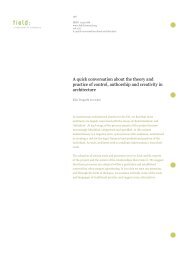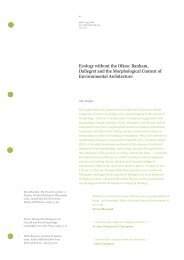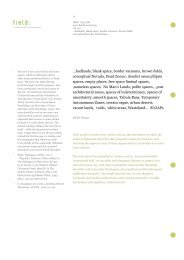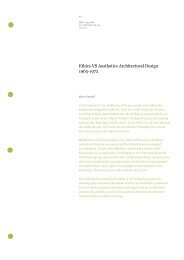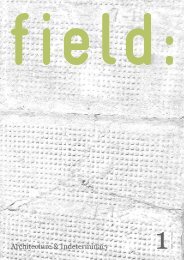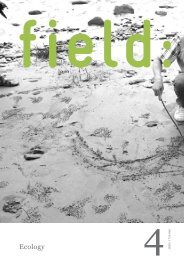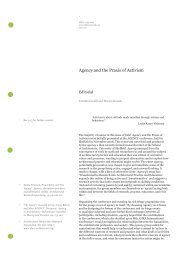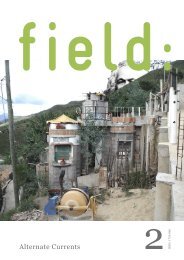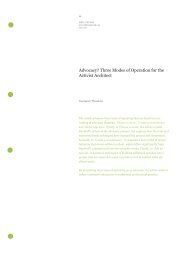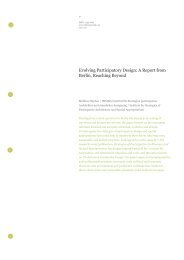2 Ecology and the Art of Sustainable Living - field journal
2 Ecology and the Art of Sustainable Living - field journal
2 Ecology and the Art of Sustainable Living - field journal
Create successful ePaper yourself
Turn your PDF publications into a flip-book with our unique Google optimized e-Paper software.
17<br />
ISSN: 1755-068<br />
www.<strong>field</strong>-<strong>journal</strong>.org<br />
vol.4 (1)<br />
<strong>Ecology</strong> <strong>and</strong> <strong>the</strong> <strong>Art</strong> <strong>of</strong> <strong>Sustainable</strong> <strong>Living</strong><br />
David Haley<br />
In western culture, <strong>the</strong> concept <strong>of</strong> ecology emerged alongside quantum<br />
<strong>the</strong>ory, complexity <strong>the</strong>ory, chaos <strong>the</strong>ory, systems <strong>the</strong>ory, cybernetics <strong>and</strong><br />
psychology. Across disciplines, artists such as Marcel Duchamp, James<br />
Joyce <strong>and</strong> John Cage embraced <strong>the</strong> <strong>the</strong>ories <strong>of</strong> physics <strong>and</strong> <strong>the</strong> Surrealists,<br />
Expressionist <strong>and</strong> DaDa movements contributed almost as much to<br />
psychology as <strong>the</strong>y gained from it. With notable exceptions, until very<br />
recently few artists have taken up <strong>the</strong> issues <strong>of</strong> ecology. Now, as we face<br />
combinations <strong>of</strong> <strong>the</strong> most dire social <strong>and</strong> environmental crises known to<br />
our kind, has ecology found its time? How might arts practices address<br />
<strong>the</strong>se issues? What can art <strong>and</strong> ecology contribute to resolving ‘<strong>the</strong><br />
carousel’ <strong>of</strong> challenges?<br />
Using examples <strong>of</strong> projects by Helen Mayer Harrison, Newton Harrison<br />
<strong>and</strong> myself, this paper considers <strong>the</strong> concepts, <strong>the</strong> practices <strong>and</strong> <strong>the</strong><br />
teachings <strong>of</strong> a whole systems approach to ecological art. It fur<strong>the</strong>r places<br />
ecological art in a practical context that <strong>of</strong>fers some tangible approaches<br />
to shifting <strong>the</strong> paradigm from <strong>Sustainable</strong> Development to ‘sustainable<br />
living’, ‘ecological resilience’ <strong>and</strong> ‘futures capabilities’. One <strong>of</strong> <strong>the</strong><br />
contributions <strong>the</strong> arts may <strong>of</strong>fer is ‘keeping <strong>the</strong> discourse plastic’.
18<br />
www.<strong>field</strong>-<strong>journal</strong>.org<br />
vol.4 (1)<br />
<strong>Ecology</strong> <strong>and</strong> <strong>the</strong> <strong>Art</strong> <strong>of</strong> <strong>Sustainable</strong> <strong>Living</strong><br />
RESILIENCE<br />
As tipping points pass<br />
Believing what is normal<br />
Grace under pressure<br />
Pr<strong>of</strong>ound distractions<br />
Vanity <strong>of</strong> vanities<br />
Left to <strong>the</strong> Market<br />
On <strong>the</strong> ship <strong>of</strong> fools<br />
Singing deaf <strong>and</strong> dancing blind<br />
Now, we’re acting mad<br />
---------------<br />
Elite ignorance<br />
Inertia from white box brains<br />
Expert arrogance<br />
In a complex world<br />
Leading a child by <strong>the</strong> h<strong>and</strong><br />
Here, under <strong>the</strong> sun<br />
Not so much knowledge<br />
<strong>Living</strong> in a quantum world<br />
A shift in thinking<br />
-------------<br />
Create <strong>and</strong> destroy<br />
The rhythm <strong>of</strong> Shiva’s drum<br />
Never stop dancing<br />
Richness <strong>of</strong> life<br />
You to me to <strong>the</strong>m as one<br />
This is all <strong>the</strong>re is<br />
As <strong>the</strong> globe warms<br />
The o<strong>the</strong>r side <strong>of</strong> collapse<br />
My tears taste <strong>of</strong> salt<br />
<strong>Ecology</strong> <strong>and</strong> <strong>the</strong> <strong>Art</strong> <strong>of</strong> <strong>Sustainable</strong> <strong>Living</strong> David Haley
19<br />
www.<strong>field</strong>-<strong>journal</strong>.org<br />
vol.4 (1)<br />
Fig. 1.One Man, One Tree, One River, One Day – River Eden, Carlisle.<br />
Photo: David Haley, 2008.<br />
In November 2007 I was invited to lead an <strong>Art</strong>s <strong>and</strong> <strong>Ecology</strong> Master Class<br />
for postgraduate arts, design <strong>and</strong> architecture students at <strong>the</strong> Guangzou<br />
Academy <strong>of</strong> Fine <strong>Art</strong>, China. The programme met with much success, so I<br />
developed it fur<strong>the</strong>r, for a ‘charrette’ with similar students <strong>and</strong> pr<strong>of</strong>essors<br />
at <strong>the</strong> National Kaohsiung Normal University, Taiwan, in April 2008.<br />
This paper is a developmental summary <strong>of</strong> that programme <strong>and</strong> it<br />
continues to evolve each time I present it. Audiences have included<br />
artists, earth scientists, hydrologists, engineers, cultural sociologists, fishfarmers,<br />
architects, students <strong>and</strong> educationalists in Plymouth, Ghent,<br />
Beijing, Cambridge, Shef<strong>field</strong>, Bristol, Budhai (Taiwan), Manchester <strong>and</strong><br />
Aberdeen. It is a kind <strong>of</strong> polemic, a discourse, a dialogue <strong>and</strong> potentially<br />
a manifesto for shifting <strong>the</strong> way we might proceed in <strong>the</strong> world. For some<br />
this attempt at a world-view or broad brushstroke approach may not sit<br />
well with analytical forms <strong>of</strong> academic research <strong>and</strong>, to some extent this<br />
is <strong>the</strong> crux <strong>of</strong> <strong>the</strong> matter, as <strong>the</strong> arts-led, practice-based research methods<br />
<strong>of</strong>fered here consider ‘convergent knowledge’ from many disciplines to<br />
construct situations for new underst<strong>and</strong>ings to emerge. Those forms<br />
<strong>of</strong> underst<strong>and</strong>ing are sometimes embedded in iterative, intuitive,<br />
improvisational, tacit <strong>and</strong> experiential means <strong>of</strong> inquiry. George Lak<strong>of</strong>f<br />
<strong>and</strong> Mark Johnson exp<strong>and</strong> on this idea in <strong>the</strong>ir book, Philosophy in <strong>the</strong><br />
Flesh:<br />
<strong>Ecology</strong> <strong>and</strong> <strong>the</strong> <strong>Art</strong> <strong>of</strong> <strong>Sustainable</strong> <strong>Living</strong> David Haley
1 George Lak<strong>of</strong>f <strong>and</strong> Mark Johnson<br />
Philosophy in <strong>the</strong> Flesh. The<br />
Embodied Mind <strong>and</strong> Its Challenge<br />
to Western Thought (New York:<br />
Basic Books, 1999), p.91.<br />
2 Hans Dieleman, The Competencies <strong>of</strong><br />
<strong>Art</strong>ful Doing <strong>and</strong> <strong>Art</strong>ful Knowing in<br />
Higher Education for Sustainability,<br />
in 'Agents <strong>of</strong> Change', http://<br />
agents<strong>of</strong>changeproject.blogspot.<br />
com/2010_07_01_archive.html (2010)<br />
20<br />
www.<strong>field</strong>-<strong>journal</strong>.org<br />
vol.4 (1)<br />
‘What fills out embodied realism, permitting us to move far beyond<br />
mere observation <strong>and</strong> manipulation, are several crucial findings<br />
about our embodied <strong>and</strong> imaginative capacities.’ The second <strong>of</strong><br />
<strong>the</strong>se ‘… is <strong>the</strong> existence <strong>of</strong> conceptual metaphor, which allows us<br />
to conceptualise one domain <strong>of</strong> experience in terms <strong>of</strong> ano<strong>the</strong>r,<br />
preserving in <strong>the</strong> target domain <strong>the</strong> inferential structure <strong>of</strong> <strong>the</strong><br />
source domain… Such inferences can <strong>the</strong>n be projected onto<br />
scientific subject matters to give explanatory accounts for existing<br />
data <strong>and</strong> to make predictions.’ … Each subject matter is thus a<br />
test bed for such a <strong>the</strong>ory. We speak <strong>of</strong> evidence for a scientific<br />
<strong>the</strong>ory as being “convergent” when <strong>the</strong> results all support <strong>the</strong> same<br />
explanatory hypo<strong>the</strong>sis.’ 1<br />
Shifting from a description <strong>of</strong> <strong>the</strong> pedagogical process, <strong>the</strong> paper engages<br />
<strong>the</strong> reader directly in <strong>the</strong> issues that were generated by <strong>the</strong> master class,<br />
charrette <strong>and</strong> subsequent presentations, each <strong>of</strong> which I consider to be<br />
performances in <strong>the</strong>ir own right, <strong>and</strong> central to artistic way <strong>of</strong> knowing, or<br />
as social scientist, Hans Dieleman puts it:<br />
<strong>Art</strong>ful doing/knowing is a way to explore <strong>and</strong> underst<strong>and</strong> reality,<br />
not limiting oneself to scientific methods, <strong>the</strong>ory or scientific<br />
language. It uses <strong>the</strong> whole repertoire <strong>of</strong> human experiences such<br />
as images, ideas <strong>and</strong> practices gained throughout life. It results<br />
in insights, visions <strong>and</strong> symbolic meaning that is communicated<br />
through a range <strong>of</strong> means <strong>of</strong> communication such as painting,<br />
sculpture, interventions, literature, music <strong>and</strong> <strong>the</strong> like. 2<br />
Fig. 2. Bubble World, Making Our Futures Master Class, Guangzhou<br />
Academy <strong>of</strong> Fine <strong>Art</strong>s, China. Photo: David Haley, 2007.<br />
<strong>Ecology</strong> <strong>and</strong> <strong>the</strong> <strong>Art</strong> <strong>of</strong> <strong>Sustainable</strong> <strong>Living</strong> David Haley
3 David Bohm et al, ‘Dialogue: A<br />
Proposal’ at http://world.std.com/~lo/<br />
bohm/0000.html (1991), p.5.<br />
4 Paul Klee, Pedagogical Sketchbook<br />
(London: Faber <strong>and</strong> Faber, 1989), p.1.<br />
21<br />
www.<strong>field</strong>-<strong>journal</strong>.org<br />
vol.4 (1)<br />
Fig. 3 Sea Level Rise Tank, Making Our Futures Master Class, Guangzhou<br />
Academy <strong>of</strong> Fine <strong>Art</strong>s, China. Photo: David Haley, 2007.<br />
Fig. 4 Lagoon Guide, A Dialogue with Oysters: <strong>the</strong> <strong>Art</strong> <strong>of</strong> Facilitation,<br />
commissioned by Tropic <strong>of</strong> Cancer Project, Budhai, Taiwan. Photo: David<br />
Haley, 2008.<br />
The art <strong>of</strong> making futures<br />
So, to <strong>the</strong> pedagogical programme itself, <strong>and</strong> as David Bohm wrote,<br />
‘dialogue is not about new knowledge, but new ways <strong>of</strong> thinking.’ 3 I drew<br />
upon Paul Klee’s Pedagogical Sketchbook as <strong>the</strong> guiding metaphor. He<br />
begins with <strong>the</strong> words: ‘An active line on a walk, moving freely, without<br />
a goal’ 4 <strong>and</strong> draws us into a Tantric-like treatise on becoming. Ano<strong>the</strong>r<br />
word for becomingness is grace.<br />
<strong>Ecology</strong> <strong>and</strong> <strong>the</strong> <strong>Art</strong> <strong>of</strong> <strong>Sustainable</strong> <strong>Living</strong> David Haley
5 R. Nicholls, R. & R. Tol, ‘Impacts<br />
<strong>and</strong> responses to sea-level rise: a<br />
global analysis <strong>of</strong> <strong>the</strong> SRES scenarios<br />
over <strong>the</strong> twenty-first century.’<br />
Philosophical Transactions <strong>of</strong> The<br />
Royal Society (2006) 364: 1073-1095.<br />
6 Richard Leakey, The Sixth Extinction:<br />
Biodiversity <strong>and</strong> its Survival.<br />
(Phoenix, London. 1996)<br />
7 Donella Meadows, Dennis Meadows<br />
& Jogen R<strong>and</strong>ers, Beyond <strong>the</strong> Limits:<br />
Global Collapse or <strong>Sustainable</strong> Future<br />
(London: EarthscanPublications, 1995)<br />
22<br />
www.<strong>field</strong>-<strong>journal</strong>.org<br />
vol.4 (1)<br />
The art <strong>of</strong> observation<br />
The Master Class <strong>and</strong> charrette accepted Global Warming <strong>and</strong> Climate<br />
Change as given. We <strong>the</strong>n took on <strong>the</strong> probabilities <strong>of</strong> sea level rise,<br />
combined with increased storm activity <strong>and</strong> intensity. This called upon<br />
some <strong>of</strong> <strong>the</strong> data that had contributed to ‘Greenhouse Britain: Losing<br />
Ground, Gaining Wisdom,’ 5 a project I developed with Helen Mayer<br />
Harrison <strong>and</strong> Newton Harrison. Although <strong>the</strong> predictions provided by <strong>the</strong><br />
Tyndall Centre for Climate Change in mid-2007 seem ra<strong>the</strong>r conservative<br />
now, it was <strong>the</strong> first time <strong>the</strong> Tyndall Centre had combined increasing sea<br />
level volume with storm surges. Recent information about <strong>the</strong> acceleration<br />
<strong>of</strong> ice-melt <strong>and</strong> permafrost thaw, reduce <strong>the</strong> timescales dramatically.<br />
We <strong>the</strong>n considered species extinction <strong>and</strong> how, according to some, it has<br />
already passed <strong>the</strong> tipping point towards <strong>the</strong> Sixth, or Holocene Extinction<br />
Event. 6 Related to this, <strong>the</strong>re’s <strong>the</strong> biggest taboo subject <strong>of</strong> <strong>the</strong>m all, <strong>the</strong><br />
exponential increase in human population. Donella <strong>and</strong> Donald Meadows7 flagged-up <strong>the</strong> impending catastrophe <strong>of</strong> exceeding <strong>the</strong> planet’s physical<br />
capacity some years ago but few governments apart from <strong>the</strong> Chinese are<br />
willing to even admit it.<br />
I was, in fact, amazed that <strong>the</strong> students I worked with in Guangzou,<br />
China, seemed to have a good awareness <strong>of</strong> some <strong>of</strong> <strong>the</strong>se issues <strong>and</strong> <strong>the</strong>y<br />
were certainly aware <strong>of</strong> <strong>the</strong> levels <strong>of</strong> pollution. However, most were sure<br />
that <strong>the</strong> State was in control <strong>of</strong> <strong>the</strong> situation <strong>and</strong> that it would come up<br />
with technological solutions. Interestingly, <strong>the</strong> Kaohsiung, Taiwanese<br />
students had similar levels <strong>of</strong> knowledge, but were less confident <strong>of</strong> <strong>the</strong>ir<br />
Government’s ability to cope.<br />
Fig 5. Tide Turns, Waters Dance: The Writing on <strong>the</strong> Wall, commission<br />
by Bamboo Culture International, Tamshui, Taiwan. Photo: David Haley,<br />
2007.<br />
<strong>Ecology</strong> <strong>and</strong> <strong>the</strong> <strong>Art</strong> <strong>of</strong> <strong>Sustainable</strong> <strong>Living</strong> David Haley
8 Helen Mayer Harrison & Newton<br />
Harrison, D. Haley, Greenhouse Britain:<br />
Losing Ground, Gaining Wisdom, An<br />
artwork. See: http://greenhousebritain.<br />
greenmuseum.org/ (2007)<br />
9 Nicholas Stern, The Stern Review'<br />
(HM Treasury, UK Government,<br />
2006) at http://www.hm-treasury.<br />
gov.uk/stern_review_report.htm<br />
23<br />
www.<strong>field</strong>-<strong>journal</strong>.org<br />
vol.4 (1)<br />
Fig. 6 Kids with Frog Spawn, A Walk On The Wild Side, Manchester.<br />
Photo: David Haley, 2007.<br />
The art <strong>of</strong> urgency<br />
So, let us, now, consider some <strong>of</strong> <strong>the</strong> basic consequences <strong>of</strong> <strong>the</strong><br />
Environmental Crisis.<br />
Over <strong>the</strong> next hundred years, l<strong>and</strong> loss caused by sea level rise (5 to 10<br />
metres) is not that much, maybe 10%, but <strong>the</strong> l<strong>and</strong> that is lost <strong>and</strong> <strong>the</strong><br />
incursion <strong>of</strong> saline water will have dramatic impacts on l<strong>and</strong> use <strong>and</strong><br />
<strong>the</strong> availability <strong>of</strong> freshwater. 8 As human beings, let alone artists <strong>and</strong><br />
designers, I believe we need to invent new ways to produce food <strong>and</strong><br />
generate freshwater, learn how to manage <strong>the</strong> migration <strong>of</strong> species <strong>and</strong><br />
people, design new forms <strong>of</strong> dwelling <strong>and</strong> control population, sequester<br />
carbon <strong>and</strong> fulfil energy needs, consume less <strong>and</strong> produce no waste. We<br />
need to devise <strong>and</strong> implement new economic systems. You don’t have to<br />
be an economist to see that <strong>the</strong> global, market-led economy doesn’t work –<br />
<strong>the</strong> current depression has evidenced that.<br />
The art <strong>of</strong> learning<br />
But why <strong>Art</strong>? How can art contribute? I think it is true to say that not long<br />
ago most people thought that climate change was about science (even<br />
if <strong>the</strong>y felt <strong>the</strong>y <strong>the</strong>mselves to be somehow to blame). Then along came<br />
Sir Nicholas Stern9 <strong>and</strong> <strong>the</strong> scientific monopoly on Climate Change was<br />
broken, as politicians <strong>and</strong> <strong>the</strong> general public understood Climate Change<br />
to be <strong>the</strong> main driver <strong>of</strong> economics… <strong>and</strong> may even be largely driven by<br />
economics. Our guilt, however, was maintained as <strong>the</strong> economics was<br />
supposedly driven by our lifestyle, our culture. So I would say, it is in<br />
culture as society, culture as ethos <strong>and</strong> culture as a creative medium that<br />
we may find a role for <strong>the</strong> arts to address environmental crises.<br />
<strong>Ecology</strong> <strong>and</strong> <strong>the</strong> <strong>Art</strong> <strong>of</strong> <strong>Sustainable</strong> <strong>Living</strong> David Haley
10 F. Forsy<strong>the</strong>, ‘Problem Based Learning’<br />
in The H<strong>and</strong>book for Economics<br />
Lecturers Higher Education Association,<br />
Economics Network. (2002). Chapter<br />
2.1 at http://www.economicsnetwork.<br />
ac.uk/h<strong>and</strong>book/pbl/21.htm<br />
24<br />
www.<strong>field</strong>-<strong>journal</strong>.org<br />
vol.4 (1)<br />
Even in its less esoteric sense, I believe that our society needs <strong>the</strong> creative<br />
thinking that <strong>the</strong> arts may <strong>of</strong>fer to achieve a more balanced <strong>and</strong> diverse<br />
approach to governance. At <strong>the</strong> heart <strong>of</strong> education, at all levels, I believe<br />
<strong>the</strong>re is a great imbalance that needs to be redressed towards <strong>the</strong> serious<br />
inclusion <strong>of</strong> art. So, let us consider some <strong>of</strong> <strong>the</strong> things artists <strong>and</strong> creative<br />
people have to <strong>of</strong>fer.<br />
Fig. 7 Greenhouse Britain: Losing Ground Gaining Wisdom, Feldman Fine<br />
<strong>Art</strong>s, New York. Photo: David Haley, 2007.<br />
The problem with problems<br />
Much education is developed on <strong>the</strong> premise <strong>of</strong> ‘problem based learning’<br />
(PBL). In certain respects, PBL is more appropriate than traditional<br />
lecture-based teaching, as it promotes active participation outside <strong>of</strong><br />
<strong>the</strong> classroom. However, in <strong>the</strong> way that is most widely applied it has<br />
a fundamental flaw – it assumes that <strong>the</strong> world is a problematic that<br />
needs to be solved. Since <strong>the</strong> 1960s, generations <strong>of</strong> medics, economists,<br />
architects, engineers, designers <strong>and</strong> scientists have been trained, using<br />
PBL, 10 to believe that <strong>the</strong>y can go into <strong>the</strong> world with <strong>the</strong>ir skills to right<br />
all wrongs. One <strong>of</strong> <strong>the</strong> difficulties, I underst<strong>and</strong>, that arises from this<br />
belief is that <strong>the</strong>y only concern <strong>the</strong>mselves with identified problems – fix<br />
<strong>the</strong> problem <strong>and</strong> it has gone. The narrow focus required for this approach<br />
deals with problems in isolation, as a ‘closed system’ <strong>and</strong> deals with nei<strong>the</strong>r<br />
context nor relationships.<br />
Making questions<br />
Now let us consider a skill I observed in <strong>the</strong> students <strong>of</strong> <strong>the</strong> <strong>Art</strong> As<br />
Environment course at Manchester Metropolitan University - ‘question<br />
based learning’ (QBL). When it’s practiced intuitively by many artists<br />
<strong>Ecology</strong> <strong>and</strong> <strong>the</strong> <strong>Art</strong> <strong>of</strong> <strong>Sustainable</strong> <strong>Living</strong> David Haley
11 David Haley, ‘The Limits <strong>of</strong><br />
Sustainability: The <strong>Art</strong> <strong>of</strong> <strong>Ecology</strong>.’<br />
in. S. Kagan & V. Kirchberg, (eds.)<br />
Sustainability: A New Frontier for<br />
<strong>the</strong> <strong>Art</strong>s <strong>and</strong> Cultures (Frankfurt,<br />
Germany: VAS-Verlag, 2008), p.5.<br />
12 Fritj<strong>of</strong> Capra, ‘Eco Literacy: The<br />
Challenge for Education in <strong>the</strong> Next<br />
Century.’ Liverpool Schumacher<br />
lectures (Berkley, California, USA:<br />
Centre for Ecoliteracy,1999)<br />
13 A. Naes referenced in Fritj<strong>of</strong> Capra,<br />
The Web <strong>of</strong> Life: A New Syn<strong>the</strong>sis<br />
<strong>of</strong> Mind <strong>and</strong> Matter (London:<br />
HarperCollins, 1996), p.162.<br />
14 David Haley, ‘Reflections on <strong>the</strong> Future<br />
– “O brave new world”: a change in<br />
<strong>the</strong> wea<strong>the</strong>r,’ in A Remesar (ed.),<br />
Waterfronts <strong>of</strong> <strong>Art</strong> I, <strong>Art</strong> for Social<br />
Change (Spain: University <strong>of</strong> Barcelona,<br />
CER POLIS, 2001) p.3. www.ub.es/<br />
escult/1.htm <strong>and</strong> CD ROM pp. 97-112.<br />
25<br />
www.<strong>field</strong>-<strong>journal</strong>.org<br />
vol.4 (1)<br />
<strong>and</strong> creative people, this approach opens up situations for exploration in<br />
non-linear ways. Problems may be found <strong>and</strong> resolved, <strong>and</strong> new questions<br />
may be formed in <strong>the</strong> process. QBL is based on ‘whole systems’ seeing <strong>and</strong><br />
thinking to promote wider <strong>and</strong> deeper learning, ra<strong>the</strong>r than solutions. This<br />
is potentially an ecological approach to learning; an ‘eco-pedagogy,’ 11 or<br />
‘Eco Literacy’ 12 that is generated by <strong>the</strong> context, relationships <strong>and</strong> complex<br />
systems, not analytical, reductionist methods <strong>of</strong> underst<strong>and</strong>ing <strong>the</strong> world.<br />
In a similar vein, Arne Naes, <strong>the</strong> founder <strong>of</strong> <strong>the</strong> Deep <strong>Ecology</strong> Movement<br />
wrote:<br />
He continues:<br />
The essence <strong>of</strong> deep ecology,” he says, “is to ask deeper questions.”<br />
This is <strong>the</strong> essence <strong>of</strong> a paradigm shift. We need to be prepared to<br />
question every single aspect <strong>of</strong> <strong>the</strong> old paradigm.<br />
It questions this entire paradigm from an ecological perspective:<br />
from <strong>the</strong> perspective <strong>of</strong> our relationships to one ano<strong>the</strong>r, to future<br />
generations, <strong>and</strong> to <strong>the</strong> web <strong>of</strong> life <strong>of</strong> which we are a part. 13<br />
Above all, QBL promotes more questions <strong>and</strong> <strong>the</strong>se act as feedback loops<br />
<strong>of</strong> creativity <strong>and</strong> expansive knowledge.<br />
Knowledge, <strong>the</strong>n becomes an ‘open’ or semi-closed system, permitting<br />
outside influences to enter <strong>and</strong> pass through but without losing <strong>the</strong> form,<br />
or pattern <strong>of</strong> <strong>the</strong> entity. Knowledge may be created from <strong>the</strong> relationship<br />
<strong>of</strong> many parts <strong>and</strong> <strong>the</strong> parts may be shared by multiple disciplines; thus<br />
knowledge itself can be considered plastic, dynamic <strong>and</strong> ecological.<br />
We may <strong>the</strong>n move from Modernist, solution driven, reductionist,<br />
problem based learning that seeks certainty, beyond <strong>the</strong> dialectic <strong>of</strong><br />
Postmodernism, to an expansive, question based learning that accepts<br />
uncertainty <strong>and</strong> on to an indeterminate ‘Next Generation’ <strong>of</strong> narratives;<br />
moving on to <strong>the</strong> emergence <strong>of</strong> diverse <strong>and</strong> complex, whole systems,<br />
operating in ‘dynamic equilibrium’ – grace in evolution, becoming, or<br />
‘ecopoiesis.’ 14<br />
<strong>Ecology</strong> <strong>and</strong> <strong>the</strong> <strong>Art</strong> <strong>of</strong> <strong>Sustainable</strong> <strong>Living</strong> David Haley
15 Tim Ingold, The Perception <strong>of</strong><br />
<strong>the</strong> Environment. Essays on<br />
livelihood, dwelling <strong>and</strong> skill<br />
(London: Routledge, 2005), p.19.<br />
16 David Haley, ‘The Limits <strong>of</strong><br />
Sustainability: The <strong>Art</strong> <strong>of</strong> <strong>Ecology</strong>.’<br />
Chapter in S. Kagan & V. Kirchberg<br />
(eds.), Sustainability: A New Frontier<br />
for <strong>the</strong> <strong>Art</strong>s <strong>and</strong> Cultures (Frankfurt,<br />
Germany: VAS-Verlag, 2008), p.10.<br />
26<br />
www.<strong>field</strong>-<strong>journal</strong>.org<br />
vol.4 (1)<br />
Anthropologist, Tim Ingold argues:<br />
… organism plus environment’ should denote not a compound <strong>of</strong><br />
two things, but one indivisible totality. That totality is, in effect,<br />
a developmental system (cf. Oyama 1985), <strong>and</strong> an ecology <strong>of</strong><br />
life – in my terms – is one that would deal with <strong>the</strong> dynamics<br />
<strong>of</strong> such systems. Now if this view is accepted – if, that is, we are<br />
prepared to treat form as emergent within <strong>the</strong> life-process – <strong>the</strong>n, I<br />
contend, we have no need to appeal to a distinct domain <strong>of</strong> mind, to<br />
creatura ra<strong>the</strong>r than pleroma, to account for pattern <strong>and</strong> meaning<br />
in <strong>the</strong> world. We do not, in o<strong>the</strong>r words, have to think <strong>of</strong> mind or<br />
consciousness as a layer <strong>of</strong> being over <strong>and</strong> above that <strong>of</strong> <strong>the</strong> life <strong>of</strong><br />
organisms, in order to account for <strong>the</strong>ir creative involvement in<br />
<strong>the</strong> world. Ra<strong>the</strong>r, what we may call mind is <strong>the</strong> cutting edge <strong>of</strong><br />
<strong>the</strong> life process itself, <strong>the</strong> ever-moving front <strong>of</strong> what Alfred North<br />
Whitehead (1929: 314) called a ‘creative advance into novelty.’ 15<br />
Fig. 8 David Haley Performing 350 St John’s Street, Liverpool. Photo: M<br />
Yates, 2009.<br />
The ennobling question<br />
Now I would like to introduce a concept developed by Newton Harrison<br />
<strong>of</strong> <strong>the</strong> ‘Ennobling Problem’, but I prefer <strong>the</strong> ‘Ennobling Question.’ 16 The<br />
principle came from discussions we had while on a lecture tours 2006/7,<br />
<strong>and</strong> focuses on <strong>the</strong> notion <strong>of</strong> ‘post-disciplinarity’. In practical terms,<br />
<strong>the</strong> Ennobling Question may dissolve <strong>the</strong> old art/science dialectic. If an<br />
Ennobling Question is placed at <strong>the</strong> centre <strong>of</strong> our collective concerns –<br />
in this case Climate Change -, it could promote opportunities for ALL<br />
disciplines to engage with it on an equal footing. None <strong>of</strong> <strong>the</strong> disciplines<br />
would be threatened. All are valued for <strong>the</strong>ir particular contribution<br />
<strong>Ecology</strong> <strong>and</strong> <strong>the</strong> <strong>Art</strong> <strong>of</strong> <strong>Sustainable</strong> <strong>Living</strong> David Haley
17 David Haley, ‘Reflections on <strong>the</strong> Future<br />
– “O brave new world”: a change in<br />
<strong>the</strong> wea<strong>the</strong>r,’ in A Remesar (ed.),<br />
Waterfronts <strong>of</strong> <strong>Art</strong> I, <strong>Art</strong> for Social<br />
Change (Spain: University <strong>of</strong> Barcelona,<br />
CER POLIS, 2001), p.7. www.ub.es/<br />
escult/1.htm <strong>and</strong> CD ROM pp. 97-112<br />
18 N Harrison, referenced in David<br />
Haley, ‘The Limits <strong>of</strong> Sustainability:<br />
The <strong>Art</strong> <strong>of</strong> <strong>Ecology</strong>.’ Chapter in<br />
S. Kagan & V. Kirchberg (eds.),<br />
Sustainability: A New Frontier for<br />
<strong>the</strong> <strong>Art</strong>s <strong>and</strong> Cultures (Frankfurt,<br />
Germany: VAS-Verlag, 2008), p.9.<br />
19 Illia Prigogine, Is Future Given?<br />
(World Scientific Publishing Co.<br />
Pte Ltd.London, 2003), p. 39.<br />
27<br />
www.<strong>field</strong>-<strong>journal</strong>.org<br />
vol.4 (1)<br />
<strong>and</strong> <strong>the</strong>reby increasing <strong>the</strong> robustness <strong>of</strong> each discipline, while applying<br />
maximum attention to <strong>the</strong> most urgent issues <strong>of</strong> our time.<br />
This, in turn, raises questions about education <strong>and</strong> my opinion that all<br />
school <strong>and</strong> university departments, all funding <strong>and</strong> research councils need<br />
to place Global Warming/Climate Change at <strong>the</strong> centre <strong>of</strong> <strong>the</strong>ir curriculum.<br />
If, indeed, <strong>the</strong> combined environmental crises <strong>of</strong> Global Warming, Climate<br />
Change, <strong>the</strong> Sixth Extinction <strong>and</strong> <strong>the</strong> human ‘population explosion were<br />
addressed by an ‘eco-centric culture,’ 17 operating as a whole system, <strong>the</strong><br />
interdependence <strong>of</strong> <strong>the</strong>se issues would be revealed.<br />
I consider this response to be very necessary, as governments, commerce<br />
<strong>and</strong> industry control <strong>the</strong> Global Warming/Climate Change discourse<br />
to maintain <strong>the</strong> status quo <strong>and</strong> normative values <strong>of</strong> our increasingly<br />
monocultural society – energy, security, economics. This may <strong>the</strong>n<br />
suggest that a role <strong>of</strong> art is to intervene <strong>and</strong> ‘keep <strong>the</strong> discourse plastic.’ 18<br />
How to make an intervention<br />
So, how might <strong>the</strong> arts engage, or intervene in this discourse? One<br />
response is that a person may join a system or a discourse anywhere <strong>and</strong> at<br />
any time.<br />
Then you might ask: ‘What needs to be done?’ It seems that <strong>the</strong> dominant<br />
culture will always appropriate <strong>the</strong> discourse for its own ends (for example,<br />
<strong>the</strong> way in which television, radio <strong>and</strong> newspapers prioritise <strong>the</strong> news,<br />
based on <strong>the</strong> agenda <strong>of</strong> proprietary politics, societal norms <strong>and</strong> belief<br />
systems). There’s nothing necessarily sinister in this. It’s how a culture<br />
becomes dominant. However, if society itself is to find new meanings <strong>and</strong><br />
evolve, it needs to shift <strong>the</strong> language as a continuing act <strong>of</strong> creativity –<br />
inventing <strong>and</strong> re-inventing. This, I believe, is ano<strong>the</strong>r role available to art<br />
- flipping <strong>the</strong> metaphors to gain new attention, new connections <strong>and</strong> above<br />
all, to change <strong>the</strong> story <strong>of</strong> <strong>the</strong> future. As Ilya Prigogine writes:<br />
He continues:<br />
The inclusion <strong>of</strong> irreversibility changes our view <strong>of</strong> nature. The<br />
future is no longer given. Our world is a world <strong>of</strong> continuous<br />
“construction” ruled by probabilistic laws <strong>and</strong> no longer a kind <strong>of</strong><br />
automaton.<br />
We are led from a world <strong>of</strong> “being” to a world <strong>of</strong> “becoming.” 19<br />
Therefore, ano<strong>the</strong>r function <strong>of</strong> art might be for artists <strong>and</strong> creative<br />
people to create <strong>the</strong> capability to envision many possibilities for many<br />
futures, or as Scottish artist Eduardo Paolozzi called for: ‘… an endless<br />
<strong>Ecology</strong> <strong>and</strong> <strong>the</strong> <strong>Art</strong> <strong>of</strong> <strong>Sustainable</strong> <strong>Living</strong> David Haley
20 Eduardo Paolozzi, Lost Magic<br />
Kingdoms: <strong>and</strong> Six Paper Moons<br />
from Nahuatl (British Museum<br />
Publications, London, 1985), p. 7.<br />
21 Aldous Huxley, Brave New<br />
World Revisited (HarperCollins,<br />
London, 2007), p.27.<br />
22 Richard Slaughter, Futures Beyond<br />
Dystopia: Creating Social Foresight<br />
(RoutledgeFalmer, London, 2004), p.3.<br />
23 Stewart Br<strong>and</strong>, The Clock <strong>of</strong> <strong>the</strong> Long<br />
Now: Time <strong>and</strong> Responsibility (London:<br />
Phoenix Paperbacks, 1999), p 163.<br />
24 Christopher Alex<strong>and</strong>er, et al, A New<br />
Theory <strong>of</strong> Urban Design (New York:<br />
Oxford University Press, 1987), p 67.<br />
25 F. Varela, E. Thompson & E. Rosch, The<br />
Embodied Mind: Cognitive Science <strong>and</strong><br />
Human Experience (The MIT Press,<br />
Cambridge, Massachusetts,1993), p.23.<br />
28<br />
www.<strong>field</strong>-<strong>journal</strong>.org<br />
vol.4 (1)<br />
set <strong>of</strong> combinations a new culture in which way problems give way to<br />
capabilities.’ 20<br />
To map a <strong>field</strong> <strong>of</strong> play<br />
The questions continue: How may we find our ‘<strong>field</strong> <strong>of</strong> play’ – <strong>the</strong> place,<br />
<strong>the</strong> timescale <strong>and</strong> collaborators for a project? And this prompts three<br />
questions. Many o<strong>the</strong>rs may follow, but <strong>the</strong>se may initially help to situate<br />
<strong>and</strong> contextualise a project, set working parameters <strong>and</strong> define <strong>the</strong> limits<br />
<strong>of</strong> its concerns. While at first this strategy might sound constraining,<br />
I believe it opens-up deeper possibilities by maintaining attention <strong>and</strong><br />
avoiding what Aldus Huxley referred to as, ‘… man's almost infinite<br />
appetite for distractions.’ 21<br />
The first question is used by The Harrisons in all <strong>the</strong>ir works, “How big<br />
is here?” In l<strong>and</strong>scape terms, it’s necessary to find <strong>the</strong> geophysical forms<br />
<strong>and</strong> eco-systemic character that provide <strong>the</strong> natural boundaries to which<br />
<strong>the</strong> project may be applied. It may be <strong>the</strong> watershed, l<strong>and</strong>mass, or coastal<br />
form, but until <strong>the</strong> <strong>field</strong> <strong>of</strong> play is established - <strong>the</strong> place <strong>of</strong> concern, <strong>the</strong><br />
<strong>the</strong>atre <strong>of</strong> operation – <strong>the</strong> project will be lost to <strong>the</strong> whims <strong>of</strong> o<strong>the</strong>rs.<br />
Next, “How long is now?” This question is derived from ‘Integral<br />
Futures Studies.’ 22 ‘How long is now?’ considers <strong>the</strong> timescale for <strong>the</strong><br />
work in h<strong>and</strong>. The anecdote from The Clock <strong>of</strong> <strong>the</strong> Long Now is that<br />
many indigenous peoples think <strong>of</strong> ‘now’ as being seven generations past<br />
<strong>and</strong> seven generations to <strong>the</strong> future – about 375 years. 23 Compare this<br />
with an electronic nano-second, or a geological event <strong>of</strong> millennia. What<br />
is a temporary artwork? What is a long-term investment? How long will<br />
London, Kaohsiung, Guangzou or Liverpool be situated in <strong>the</strong>ir current<br />
geographical positions?<br />
Finally, “Who is here now?” This brings <strong>the</strong> first two questions<br />
toge<strong>the</strong>r. In time <strong>and</strong> space, you have to know with whom you will work?<br />
Who is <strong>the</strong> work for (human <strong>and</strong> non-humans alike)? How will <strong>the</strong> work<br />
impact on those who are here, now?<br />
And this leads us to an extra rhetorical question <strong>and</strong> guiding principle<br />
that Christopher Alex<strong>and</strong>er suggests in his book, A New Theory <strong>of</strong> Urban<br />
Design: “What is <strong>the</strong> most important thing that I can do now, at this<br />
moment, to bring <strong>the</strong> whole to life.” 24<br />
There is an anecdotal truism that, ‘artists are like explorers - <strong>the</strong>y are<br />
permanently lost’. Not to be confused with being misplaced, or going<br />
astray, this state <strong>of</strong> deliberate ‘lostness’, or <strong>the</strong> practice <strong>of</strong> ‘mindfulness/<br />
awareness’ 25 is concerned with a realisation <strong>of</strong> st<strong>and</strong>ing at <strong>the</strong> abyss <strong>of</strong><br />
now, gazing to <strong>the</strong> future. This may be unnerving for some people (clients,<br />
collaborators, stakeholders, funders, designers, engineers – typically, <strong>the</strong>y<br />
<strong>Ecology</strong> <strong>and</strong> <strong>the</strong> <strong>Art</strong> <strong>of</strong> <strong>Sustainable</strong> <strong>Living</strong> David Haley
26 Fritj<strong>of</strong> Capra, The Web <strong>of</strong> Life: A<br />
New Syn<strong>the</strong>sis <strong>of</strong> Mind <strong>and</strong> Matter<br />
(London: HarperCollins, 1996), p.36.<br />
29<br />
www.<strong>field</strong>-<strong>journal</strong>.org<br />
vol.4 (1)<br />
like a clear brief that delivers predetermined criteria) but this state <strong>of</strong><br />
being lost, this uncertainty, this realisation <strong>of</strong> indeterminacy comes with<br />
<strong>the</strong> territory <strong>of</strong> breaking new ground <strong>and</strong> seeing into <strong>the</strong> future. The above<br />
questions are like Klee’s line, mentioned above, guide <strong>the</strong> course <strong>of</strong> action<br />
<strong>and</strong> <strong>the</strong> process <strong>of</strong> <strong>the</strong> work.<br />
Fig. 9 Wild Walk 2, The Three Canals, A Walk On The Wild Side.<br />
Manchester. Photo: David Haley, 2005.<br />
Whole Systems <strong>Ecology</strong><br />
I mentioned earlier <strong>the</strong> term, ‘whole systems ecology’ <strong>and</strong> it requires some<br />
explanation.<br />
As Fritj<strong>of</strong> Capra suggests in The Web <strong>of</strong> Life: a Syn<strong>the</strong>sis <strong>of</strong> Science, 26<br />
‘systems thinking’ may denote <strong>the</strong> paradigmatic shift in thinking<br />
from Cartesian, mechanistic, atomistic, reductionism to an ecological,<br />
integrated, contextual, organic underst<strong>and</strong>ing <strong>of</strong> <strong>the</strong> whole. It emerged<br />
simultaneously during <strong>the</strong> 1920s from several disciplines, particularly<br />
quantum physics, Gestalt psychology <strong>and</strong> <strong>the</strong> biological sciences.<br />
Essentially, <strong>the</strong> pattern <strong>of</strong> <strong>the</strong> whole becomes <strong>the</strong> focus <strong>of</strong> attention, ra<strong>the</strong>r<br />
than an analysis <strong>of</strong> parts, <strong>the</strong> form ra<strong>the</strong>r than <strong>the</strong> material or components.<br />
Through quantum physics <strong>the</strong> shift from objects to relationships goes<br />
even fur<strong>the</strong>r. Capra asserts, “What we call a part is merely a pattern in<br />
an inseparable web <strong>of</strong> relationships.” This represents a radical shift in<br />
thinking from what is still regarded as <strong>the</strong> ‘norm’ <strong>of</strong> how we perceive <strong>the</strong><br />
world in contemporary Western culture – <strong>the</strong> relationship between figure<br />
<strong>and</strong> <strong>the</strong> ground shift. An object is a pattern <strong>of</strong> particles within <strong>the</strong> whole<br />
<strong>and</strong> particles are <strong>the</strong>mselves systems operating at a different systems level.<br />
<strong>Ecology</strong> <strong>and</strong> <strong>the</strong> <strong>Art</strong> <strong>of</strong> <strong>Sustainable</strong> <strong>Living</strong> David Haley
27 Ibid, p.36.<br />
28 E. Schneider & D. Sagan, Into <strong>the</strong><br />
Cool: Energy Flow, Thermodynamics,<br />
<strong>and</strong> Life (The University <strong>of</strong><br />
Chicago Press, Chicago, 2005).<br />
29 Fritj<strong>of</strong> Capra, The Web <strong>of</strong> Life: A<br />
New Syn<strong>the</strong>sis <strong>of</strong> Mind <strong>and</strong> Matter<br />
(London: HarperCollins, 1996), P.75<br />
30 Futerra, Recommendations to: UK<br />
Communications Strategy on Climate<br />
Change – Executive Summary (London:<br />
Futerra Communications Ltd. 2005)<br />
30<br />
www.<strong>field</strong>-<strong>journal</strong>.org<br />
vol.4 (1)<br />
Apart from anything else, this ‘reality’ may be pr<strong>of</strong>oundly psychologically<br />
disturbing to many people, as “… systems thinking involves a shift from<br />
objective to ‘epistemic’ science; to a framework in which epistemology –<br />
‘<strong>the</strong> method <strong>of</strong> questioning’ – becomes an integral part <strong>of</strong> <strong>the</strong> <strong>the</strong>ories.” 27<br />
This concept is, <strong>of</strong> course, central to my development <strong>of</strong> Question Based<br />
Learning.<br />
As I underst<strong>and</strong> it, three principle properties <strong>of</strong> ‘whole systems ecology’<br />
are ‘diversity’, interconnectedness, <strong>and</strong> ‘finite systems’. If we apply <strong>the</strong>se<br />
principles to contemporary environmental crises, new underst<strong>and</strong>ings may<br />
be deduced.<br />
Diversity – species richness, complexity – is <strong>the</strong> essence <strong>of</strong> evolution <strong>and</strong><br />
<strong>the</strong> continuing process <strong>of</strong> life that runs counter to entropy <strong>and</strong> <strong>the</strong> loss <strong>of</strong><br />
energy.<br />
Interconnectedness, or more importantly interdependence, provides a<br />
deeper underst<strong>and</strong>ing <strong>of</strong> how <strong>the</strong> amazing complexity <strong>of</strong> relationships<br />
work, taking <strong>the</strong> underst<strong>and</strong>ing <strong>of</strong> ecology <strong>and</strong> ecosystems to an<br />
imperative.<br />
And a third principle <strong>of</strong> whole systems ecology is, finite resources, or as <strong>the</strong><br />
supermarket sale declares, ‘when it’s gone, it’s gone’. Despite our planet’s<br />
ability to regenerate itself, <strong>the</strong>re is always loss <strong>of</strong> energy. ‘Non-equilibrium<br />
<strong>the</strong>rmodynamics’ 28 underst<strong>and</strong>s our cosmos to be moving from hot to cold<br />
through irreversible time. In <strong>the</strong> human timescale, <strong>the</strong> air we brea<strong>the</strong>,<br />
<strong>the</strong> water we drink <strong>the</strong> food we eat, <strong>the</strong> energy we release are all finite<br />
resources. We may conserve <strong>and</strong> care for <strong>the</strong>m, we may pollute <strong>and</strong> waste<br />
<strong>the</strong>m, but this is all <strong>the</strong>re is.<br />
It is important to underst<strong>and</strong> that each property - diversity,<br />
interconnectedness <strong>and</strong> finite resources – is integral to whole systems<br />
ecology <strong>and</strong> <strong>the</strong>refore interdependent. The parts cannot function<br />
independently, <strong>the</strong>y are a system. At ano<strong>the</strong>r level, <strong>the</strong>se properties<br />
might also be understood as ‘process, pattern <strong>and</strong> structure’ 29 <strong>and</strong> here<br />
we see <strong>the</strong> possibility for one system to display <strong>the</strong> properties <strong>of</strong> ano<strong>the</strong>r<br />
‘emergent’ system.<br />
Forms <strong>of</strong> resilience<br />
This brings me to <strong>the</strong> most controversial part <strong>of</strong> this paper,<br />
resilience. With regard to Global Warming <strong>and</strong> Climate Change, <strong>the</strong><br />
Intergovernmental Panel on Climate Change got to <strong>the</strong> concept <strong>of</strong><br />
resilience in 2001. But it took <strong>the</strong> UK Government <strong>and</strong> its agencies a long<br />
time to move on from ‘awareness’ <strong>and</strong> ‘behaviour’ 30 as forms <strong>of</strong> mitigation,<br />
to <strong>the</strong> need for adaptation to <strong>the</strong> inevitable changes.<br />
<strong>Ecology</strong> <strong>and</strong> <strong>the</strong> <strong>Art</strong> <strong>of</strong> <strong>Sustainable</strong> <strong>Living</strong> David Haley
31 See Brian Walker, et al ‘Exploring<br />
Resilience in Social-Ecological Systems<br />
Through Comparative Studies <strong>and</strong> Theory<br />
Development’: Introduction to <strong>the</strong> Special<br />
Issue, <strong>Ecology</strong> <strong>and</strong> Society (2006)<br />
11(1): 12, [online] URL: http://www.<br />
ecology<strong>and</strong>society.org/vol11/iss1/art12/<br />
Brian Walker, et al ‘A h<strong>and</strong>ful <strong>of</strong> heuristics<br />
<strong>and</strong> some propositions for underst<strong>and</strong>ing<br />
resilience in social-ecological systems’.<br />
<strong>Ecology</strong> <strong>and</strong> Society (2006) 11(1):<br />
13. [online] URL: http://www.<br />
ecology<strong>and</strong>society.org/vol11/iss1/art13/<br />
32 Jared Diamond, Collapse<br />
(Penguin, London. 2005)<br />
33 Richard Slaughter, Futures Beyond<br />
Dystopia: Creating Social Foresight<br />
(RoutledgeFalmer, London, 2004)<br />
31<br />
www.<strong>field</strong>-<strong>journal</strong>.org<br />
vol.4 (1)<br />
For this purpose, it is worth considering two forms <strong>of</strong> resilience,<br />
engineered resilience <strong>and</strong> ecological resilience. The former takes <strong>the</strong><br />
notion <strong>of</strong> duration, sustainability perhaps, <strong>and</strong> develops ways in which we<br />
might prolong <strong>the</strong> status quo. Retaining what we in <strong>the</strong> developed world<br />
enjoy as a comfortable lifestyle. However, this form <strong>of</strong> resilience is also<br />
akin to slavery <strong>and</strong> <strong>the</strong> process <strong>of</strong> desertification – we may endure <strong>the</strong>m,<br />
but <strong>the</strong>y are not very desirable. 31<br />
Ecological resilience, however, considers <strong>the</strong> probability <strong>of</strong> ecological<br />
perturbation, or systems collapse. Evolution is not necessarily a long<br />
steady process; it is <strong>of</strong>ten marked by dramatic shock events with equally<br />
dramatic consequences. The dinosaurs, for instance, did not survive<br />
<strong>the</strong> climate change events <strong>the</strong>y experienced. However, once we think <strong>of</strong><br />
collapse as a likely phenomenon, we are liberated to focus on how to cope,<br />
even consider life on <strong>the</strong> o<strong>the</strong>r side <strong>of</strong> collapse. 32 So, what plans <strong>and</strong><br />
strategies <strong>and</strong> skills do we need?<br />
How will we make our future(s)?<br />
We may <strong>the</strong>n consider <strong>the</strong> guiding question, ‘How will we make our<br />
futures?’ ‘Futures’, not future, because we need to include many diverse<br />
options. In fact, a diversity <strong>of</strong> futures should contribute to ecological<br />
resilience, because no one knows for sure which strategies will work.<br />
Richard Slaughter, President <strong>of</strong> <strong>the</strong> World Futures Studies Federation <strong>and</strong><br />
Director <strong>of</strong> <strong>the</strong> Australian Foresight Institute, enforces this imperative:<br />
Ra<strong>the</strong>r, it lies in escaping from – or ra<strong>the</strong>r, transcending – <strong>the</strong><br />
‘flatl<strong>and</strong>’ imposed on us by three-hundred years <strong>of</strong> reductionism <strong>and</strong><br />
epistemological narrowness. It lies in acts <strong>of</strong> recovery in each <strong>and</strong> every<br />
domain: <strong>the</strong> recovery <strong>of</strong> a deeper sense <strong>of</strong> self, <strong>of</strong> higher transcendent ways<br />
<strong>of</strong> knowing, <strong>of</strong> states <strong>of</strong> social being that go beyond <strong>the</strong> merely rational<br />
<strong>and</strong> so on. In Wilber’s words: ‘we cannot build tomorrow on <strong>the</strong> bruises<br />
<strong>of</strong> yesterday… This means a new form <strong>of</strong> society will have to evolve that<br />
integrates consciousness, culture <strong>and</strong> nature, <strong>and</strong> thus finds room for art,<br />
morals, <strong>and</strong> science – for personal values, for collective wisdom, <strong>and</strong> for<br />
technical know how. 33<br />
<strong>Art</strong>ists <strong>and</strong> creative people are said to possess certain skills <strong>and</strong> I wish<br />
to leave aside art as a commodity. I believe <strong>the</strong> objects <strong>and</strong> products are<br />
useful for publics to focus <strong>the</strong>ir attention <strong>and</strong> artists need <strong>the</strong> craft or<br />
artfulness to give form to <strong>the</strong>ir processes <strong>and</strong> stimulate cognition; art may<br />
contribute to our very existence.<br />
Finally, I would like to <strong>of</strong>fer ano<strong>the</strong>r view <strong>of</strong> futures thinking in ecology,<br />
it is an exchange I had with Sven Erik Jorgensen, a world-renowned<br />
ecological ma<strong>the</strong>matical systems modeller <strong>and</strong> Editor-in-Chief <strong>of</strong> <strong>the</strong><br />
<strong>journal</strong> Ecological Modelling. I attended a course he led in 2005 at<br />
<strong>Ecology</strong> <strong>and</strong> <strong>the</strong> <strong>Art</strong> <strong>of</strong> <strong>Sustainable</strong> <strong>Living</strong> David Haley
34 Paul Klee, Pedagogical Sketchbook<br />
(London: Faber <strong>and</strong> Faber, 1989), p.37.<br />
32<br />
www.<strong>field</strong>-<strong>journal</strong>.org<br />
vol.4 (1)<br />
<strong>the</strong> Society for Ecological Restoration World Conference in Zaragoza,<br />
Spain. At <strong>the</strong> end <strong>of</strong> <strong>the</strong> course I thanked him <strong>and</strong> asked, “… does this<br />
process <strong>of</strong> modelling produce any better questions”? He replied, that<br />
large corporations, governments <strong>and</strong> world organisations paid him lots<br />
<strong>of</strong> money to produce <strong>the</strong> familiar looking flow charts or models that are<br />
intended to bring clarity to a problem. But, he said that <strong>the</strong>y never pay him<br />
for <strong>the</strong> essential start <strong>of</strong> <strong>the</strong> process – <strong>the</strong> ‘brain-storming’, ‘think tank’,<br />
or dialogue – namely, <strong>the</strong> creative process <strong>of</strong> forming <strong>and</strong> framing <strong>the</strong><br />
questions, engaging with o<strong>the</strong>rs, <strong>and</strong> considering many approaches. This<br />
taking time must not be underestimated. Toge<strong>the</strong>r with accurate data<br />
collection, this element is <strong>the</strong> most important part, because as I would say,<br />
<strong>the</strong> whole project flows from making time a matter <strong>of</strong> urgency.<br />
And if we take <strong>the</strong> visual form <strong>of</strong> <strong>the</strong> ma<strong>the</strong>matical model, we may witness<br />
similarities with what all art does – it tells stories. In particular, we may<br />
note <strong>the</strong> function <strong>of</strong> an icon. Icons are not just <strong>the</strong> image <strong>of</strong> something,<br />
<strong>the</strong>y are <strong>the</strong> embodiment <strong>of</strong> that which <strong>the</strong>y depict – it’s not <strong>the</strong> picture <strong>of</strong><br />
<strong>the</strong> Madonna, an icon is <strong>the</strong> visual metaphor, <strong>the</strong> ‘gate’ to pass from earth<br />
to heaven to experience <strong>the</strong> Madonna. But without knowledge <strong>of</strong> <strong>the</strong> story,<br />
<strong>the</strong> lady draped in <strong>the</strong> blue shawl, holding a baby, is just a lady in a blue<br />
shawl, holding a baby. This integration <strong>of</strong> story <strong>and</strong> image forms <strong>the</strong> basis<br />
<strong>of</strong> our cultural cognition – our means <strong>of</strong> underst<strong>and</strong>ing <strong>the</strong> world. This<br />
may be <strong>the</strong> art <strong>of</strong> bringing <strong>the</strong> world into being, or <strong>the</strong> story <strong>of</strong> <strong>the</strong> art <strong>of</strong><br />
becoming?<br />
The final entry in Paul Klee’s Pedagogical Sketchbook:<br />
We have arrived at <strong>the</strong> spectral colour circle where all <strong>the</strong> arrows<br />
are superfluous. Because <strong>the</strong> question is no longer: “to move <strong>the</strong>re”<br />
but to be “everywhere” <strong>and</strong> consequently also “There!” 34<br />
<strong>Ecology</strong> <strong>and</strong> <strong>the</strong> <strong>Art</strong> <strong>of</strong> <strong>Sustainable</strong> <strong>Living</strong> David Haley


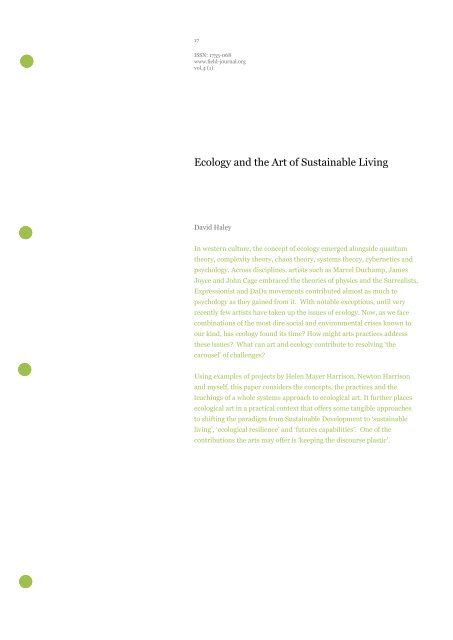
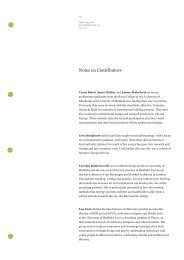
![ATLAS of Interdependence[889k] - field journal](https://img.yumpu.com/20827625/1/184x260/atlas-of-interdependence889k-field-journal.jpg?quality=85)
